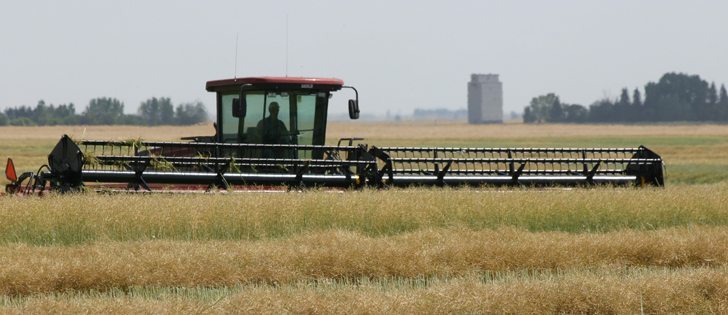Timing is key | Swathing eliminates wind damage risks; straight cutting saves time but can cause shatter and pod drop
Growers have important decisions to make as they prepare to harvest what could be one of their most lucrative canola crops.
The first decision is whether to swath or straight combine, said Angela Brackenreed, agronomy specialist with Manitoba Agriculture.
Swathing is a good option for growers with plenty of acres because timing of the harvest becomes less critical. Most producers have the equipment to put a lot of acres in the ground quickly, but few have the ability to rapidly combine a crop.
Reduced risk is the biggest benefit of swathing. A swathed crop is far less susceptible to wind damage.
Read Also

Phosphate prices to remain high
Phosphate prices are expected to remain elevated, according to Mosaic’s president.
Straight cutting is a big time saver, and research shows it has the potential to deliver increased yield, quality, oil content and seed size and decreased green seed count.
The drawbacks are shatter losses, pod drop, delayed harvest and the need for grain dryers or aeration bins because some of the acres will probably be tough and there will be green weeds with high moisture content.
Brackenreed, who was a guest speaker on a Canola Council of Canada webinar about managing harvest, said there are a number of considerations when swathing a crop.
The optimal time to swath is when there is 60 percent seed colour change in the pods located on the main stem of the plants. Most farmers are aware of that, but many still cut corners.
Growers need to walk their fields and crack open some pods. Assessing crop readiness can’t be done from the truck, no matter how long a farmer has been growing canola.
Canola plants mature from the bottom up, which means the seeds in the bottom third and most of the middle third of the plant’s main stem should be purple to brownish black in colour and those in the top third still green and firm.
Farmers should recheck their fields every day or two, keeping in mind the rule of thumb that 10 percent seed colour change happens every two to three days but can be quicker than that when the weather is hot and dry.
Another guiding principal is that it generally takes 25 days from the end of flowering to maturity in Manitoba, 30 days in Alberta and between those two numbers in Saskatchewan.
Growers can be confronted by a number of dilemmas when swathing their canola.
“In Manitoba this year, the major issue producers are faced with right now with canola is unevenly maturing stands,” said Brackenreed.
She recommended delaying swathing until seeds in the least mature areas of a field start changing colour, as long as the pods in the more mature portions of the field are not at risk of shattering.
Swathing thin stands is probably not a big issue for most producers this year but the canola will “branch like crazy” when that happens, causing more green seed counts because plants also mature from the middle out.
Producers need to assess seed colour change on the entire plant when stands are thin rather than just the main stem because there can be a lot of seed in the pods along those branches.
It’s also important to know when to swath when there is high sclerotinia disease pressure. Growers tend to want to swath early, but that’s not a good plan.
“Forget those infected plants and continue to swath at that ideal timing for the healthy plants because this is where your yield is going to be,” said Brackenreed.
“Those infected seeds aren’t going to contribute to your yield.”
Derwyn Hammond, resource manager for the canola council, said it’s not always a good idea to leave a field to 60 percent seed colour change when dealing with certain diseases.
In the case of clubroot, he recommended swathing at 30 percent seed colour change because the galls on the root system are still intact and the crop is better anchored in the soil than it is when the galls fall off.
A field with severe alternaria black spot infection is also a good candidate for straight cutting before 60 percent seed colour change because the disease dries down the pods, which can lead to extensive shatter losses.
Brackenreed said swathing in hot, dry weather is more of a challenge. It is best to wait until the evening to minimize the temperature and maximize moisture conditions.
Swathing in the heat can lead to rapid desiccation and high green seed count.
“The worst combination is to prematurely swath on a hot and dry day,” she said. “That is going to lead to the worst yield and quality loss.”
Swathing to avoid a killing frost of -2 C is only effective if done 72 hours before the frost because that allows time for the seed moisture content to fall below 20 percent.
Growers should wait four to six hours before assessing frost damage on a standing canola crop. Badly damaged pods will be white and wilted. Pod shatter can begin within a day or even quicker if temperatures are high.
Brackenreed recommended swathing immediately to avoid shatter losses if the pods are desiccating rapidly and have seed colour change on the pods on the main stem.
Growers should delay swathing if the crop lower in the canopy is not hit as hard and the seeds are still green because the seeds may continue to ripen and change colour.
She also recommended delaying swathing if there was only a light frost that caused white speckling on the pods because that doesn’t harm the seeds.
As well, producers may want to wait if the upper portion of the plant was severely damaged, allowing those pods to shell out to avoid high levels of green seed count.
“There’s going to be a large yield reduction but an increased grade,” said Brackenreed.
















